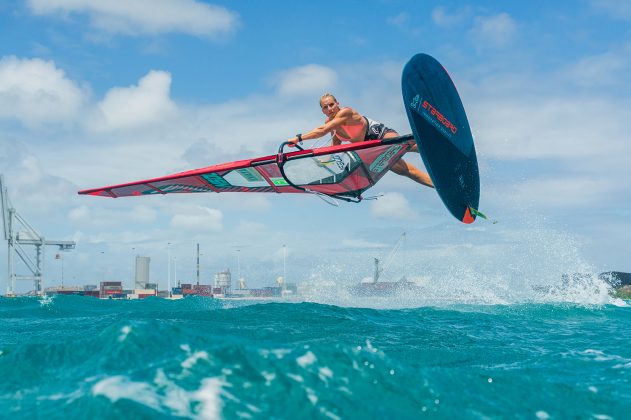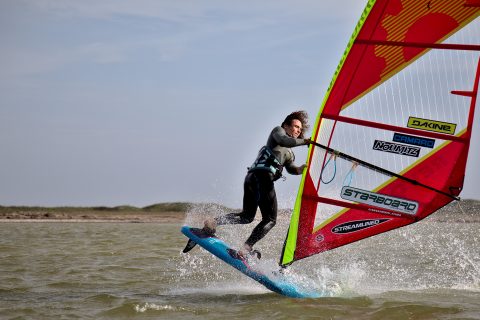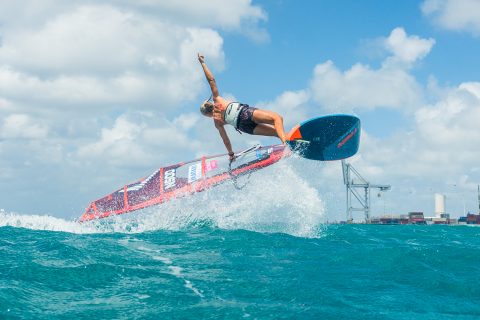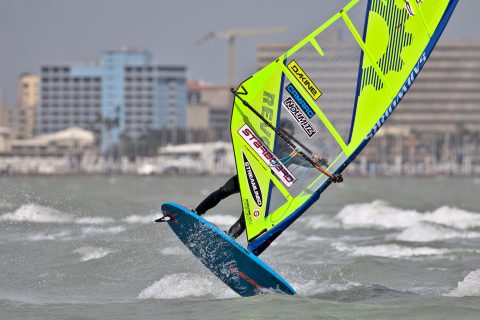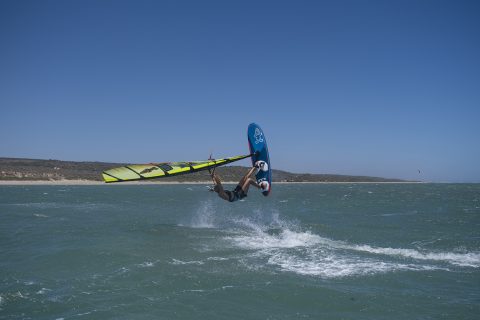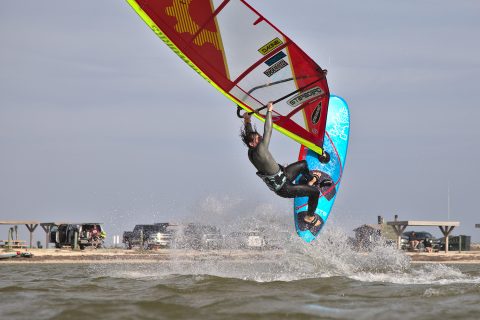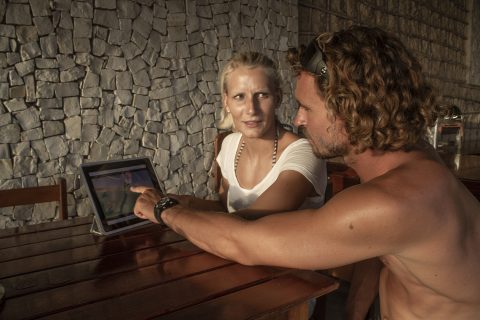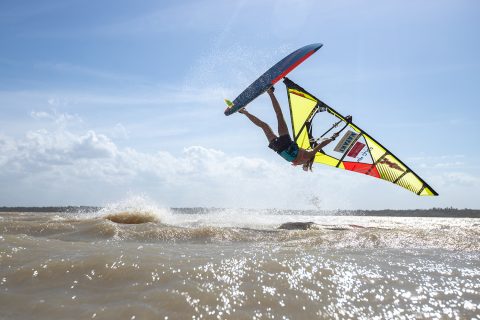Improvement tips
Professional windsurfers, Phil Soltysiak and Oda Johanne, join forces to explain how to speed up your progress in windsurfing, breaking down the learning process in a way that every windsurfer can take advantage of. Whether it is your first gybe, a smoother wave ride or the latest trick, the following tips will get you there faster.
Words by Philip Soltysiak and Oda Johanne Stokstad Brødholt // Photos – Kelsey Cardwell, Håkon Skorge, Mathias Moerman / Two Goat Media
Freestyle windsurfing evolves at an incredible pace; it’s hard even for pros to keep up. Sometimes it seems like a miracle takes place, and we will land a few new tricks in one day; sometimes we suffer a month long drought of not landing anything new, or even feel like our level is regressing. Windsurfing is a challenging sport, so all these situations are normal, and should not bring us down. The important thing if you want to progress, is to consistently work toward your goals and measure your progress, to assure that with time you improve.
- Phil in action
The following list of tips and tricks is what we have personally learnt throughout our windsurfing careers. We highly recommend you take the time to apply these to your personal windsurfing, with the goal of making consistent progress over time. For simplicity, we will assume anything you want to learn is a “move”, whether it is a beach start, jibe, wave ride or freestyle move.
Set realistic goals – Clearly define what you want to learn, and make sure it suits your current level of sailing. Challenge yourself with your goal, but make sure it’s attainable, otherwise you risk frustration and disappointment. For example, let’s say Oda’s goal was to learn a trick called the ‘burner’. It was a realistic goal because she could already duck her sail consistently, air funnel, and ponch. She had all the prerequisite moves in the bag. It was just a matter of her combining all the skills from those moves to land the ‘burner’.
Watch others – Watch others doing what you want to learn. Watch videos from various angles and in slow motion. Watch people on the water doing your move, especially those that inspire you or whose style impresses you. When you’re in the water, ask someone to do that move right in front of you if they can. Try to relive all the movements and feelings they are experiencing throughout the move in your mind.
- Oda full power
Visualize – Close your eyes, and try the move over and over in your head, thinking about every possible detail. Begin with the movements of the board, sail, and your body. Progress to as much detail as you can. For example, preparing for a competition we can imagine the nervous feeling or heat time pressure, our competitor’s board chop, etc. The more detail you can visualize, the better prepared you are for reality. Ascertain that you can consistently land the move in your mind.
Simulate – Take parts of the move and simulate them on land. For any move with a sail flip, simulating the hand work on land helps build up muscle memory which you will no longer have to learn on the water. Footwork for various jibes and tacks is also very easy to simulate on land. Phil shares his experience learning a vulcan, where simulation got him to the next level: “I landed my first vulcan in the spring of 2004, but I spent the whole summer trying to get them dialled in, and just couldn’t figure it out. One day, after crashing probably a hundred vulcans, I realised it was my sail flip that was messing me up. My hands were not fast enough, and didn’t know what to do. After taking my sail on the beach and simulating the sail flip, I returned to the water and began landing vulcan after vulcan.”
Conditions – Find the easiest conditions to do your move for the first time. Whether it is flat water, small waves, strong wind or light wind, every move has its ideal conditions. Make sure you choose your sailing spot accordingly to make the most of your session.
- Phil Soltysiak
Warm up – Invariably you will crash learning a new move. A warm up for your body not only reduces risk of injury, it also increases your level of confidence going into the move. If relevant, also warm up with a few related moves on the water.
Location – Once you are on the water, think about where you will try your move. Perhaps the best location is not where you always sail, but a little upwind or downwind. Stop sailing for a minute, and visualize yourself landing the move at your chosen location. Adapt your visualization to the conditions and location. Oda shares her experience learning a flaka, where choosing the right conditions and location helped her land her first one: “One of the most difficult moves I had to learn to date was the flaka. I spent months frustrated, trying to figure out what was going wrong. Then I decided on a trip to Bonaire; freestyle paradise. The conditions there are the easiest to learn new flat water freestyle moves. A friend told me about this great little spot for flakas in Lac Bay, where I could sail and set up for the move across flat water, and finally hit a perfect bit of chop. A few sessions later I was stoked to finally break through and land my first flakas. I learnt that the right location and conditions can make a huge difference in how quickly you learn a move.“
Commit – Commit 100% to the move you want to learn. You already decided you are ready for it, so do not try half or part of the move. Go into the move with focus, confidence and speed, believing you will land it exactly as you have already landed it hundreds of times in your mind. Don’t be afraid to crash. Any form of hesitation is the leading factor to any crash in windsurfing.
- Oda Brodholt in Australia
Catch mistakes – Between attempts at the move, take the time to think about what went wrong, and most importantly how to fix it. After a crash, visualize the necessary adjustment to get the move right the next time. If possible, try your move in front of somebody who can watch and help you catch those mistakes and help you analyse how to correct them. This is a very important step, otherwise you risk repeating the same mistakes and emblazoning them into your muscle memory.
Don’t get frustrated – Don’t lose your patience, it takes a lot of attempts and hard crashes to learn a new windsurfing move. Frustration leads to a negative approach and attitude, and these will only slow you down. Keep positive, even if things don’t go the way you hoped they would. Try putting things into perspective; after all you’re out windsurfing, doing the sport you love, would you rather be doing anything else? No way!
Take a break – Sometimes you stop making progress, begin to lose your focus, and crash in weird ways. When that starts to happen, it’s time to take a break. There is no point in logging endless hours on the water, if you will only learn mistakes, crash, and not progress. Your body needs a physical break from windsurfing, your mind needs a break from the focus required to learn something new. Give your body a reset, and let your mind subconsciously analyse and learn from your sessions. When we’re in places where it’s windy every day, we try to take a day off every week to rest and relax. Even a short time out during a long windy day on the water can be the key to breaking through to the next step.
- Phil training full power
Film – Ask a friend to film you, or take turns filming each other. Don’t film too long, as for some it can get frustrating, but it’s always useful to have some footage to look at and see how you are progressing. Review the footage with a friend either during a break or the evening after sailing. Understand the mistakes you are making, and more importantly visualize, understand, and drill into your mind the correct way of doing the move.
- Checking the video action
Video analysis – Review the footage of your day with a friend. Talk about and analyse your mistakes. Think how to improve them. Compare your attempts with video clips of people doing the move properly and carefully spot the differences. Look for all types of differences, including angle of the wind, board speed, where the sailor is looking and timing, as well as body, sail and board positioning during different parts of the move.
Claim it – When you land something new, claim it, and enjoy the moment, but more importantly, don’t forget how you did it. Remember the exact feeling of completing the move properly, so that you can relive that feeling in your mind, and ultimately relive it on the water.
- Oda having fun in Brazil
Have fun – Enjoy your time on the water. After all, that’s why we windsurf. Having fun and a positive attitude will always create a better windsurfer.
It’s astonishing how much time and effort windsurfers dedicate to their sport. The number of crashes, blisters, bruises and twisted ankles we recover from are incredible. And then there’s the frozen fingers, sun burnt noses, and missed obligations we totally forget about. It’s not a sport for the faint-hearted, and perhaps it’s the challenge that keeps us hooked. But then there are those moments, when everything comes together and you finally land something new, taking your windsurfing to the next level. That exhilarating feeling of accomplishment every windsurfer dreams of is impossible to describe, but it is undeniably addicting, and that’s what keeps us striving to clinch that next step in this beautiful sport.

